On a sunny day, who doesn’t want to stay outdoors for a while?
But the glaring sun and sultry temperatures often make outdoor time “tortured”.
Awnings and parasols, as the two main forces of outdoor sunshade, can always help us block the scorching sun – but what is the difference between them? Which one is more suitable for your courtyard, balcony or terrace?
After reading this article, you can choose the most suitable “outdoor sunshade artifact” according to your needs.
Learn about awnings
What is a retractable awning?
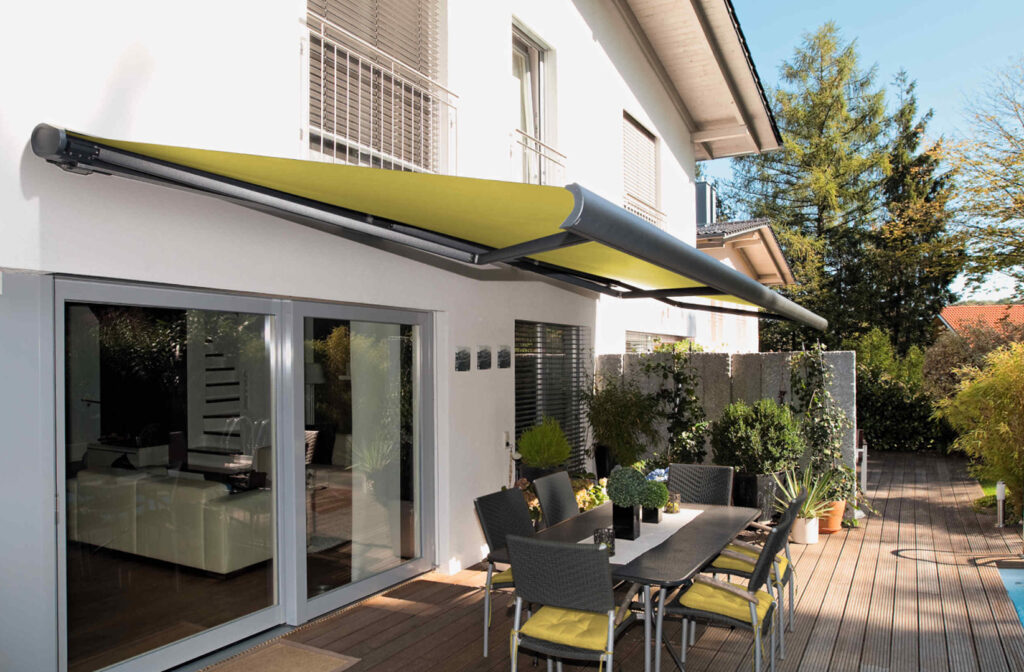
A retractable awning is an adjustable sunshade device fixed to a building, usually installed on the exterior wall of a house, the top of a balcony or the edge of a terrace.
Its core structure is an aluminum alloy or steel frame, with waterproof and sun-proof fabric (such as PVC coated fabric, acrylic fabric), and the extension is controlled by a manual rocker or electric button.
- When needed, it can provide shade for the area below.
- When not in use, it can be folded up close to the wall, taking up almost no space.
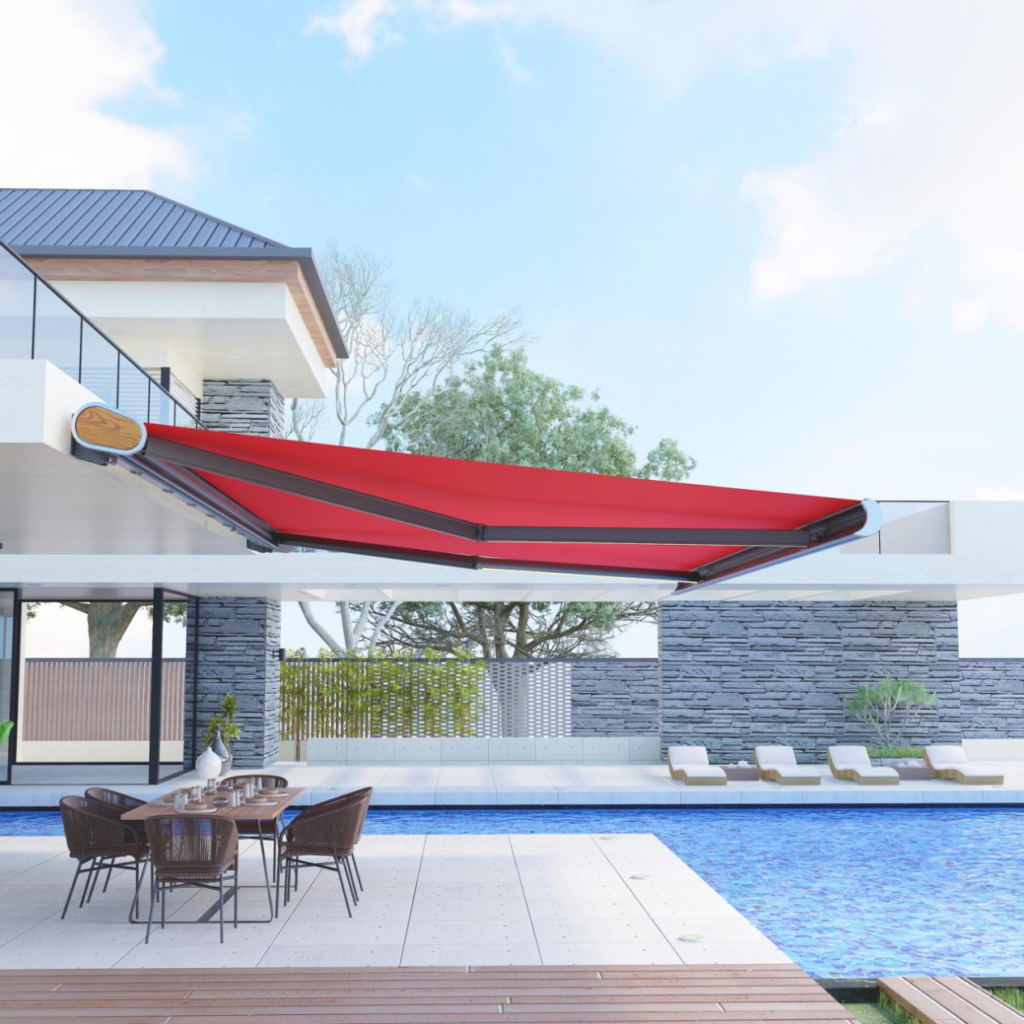
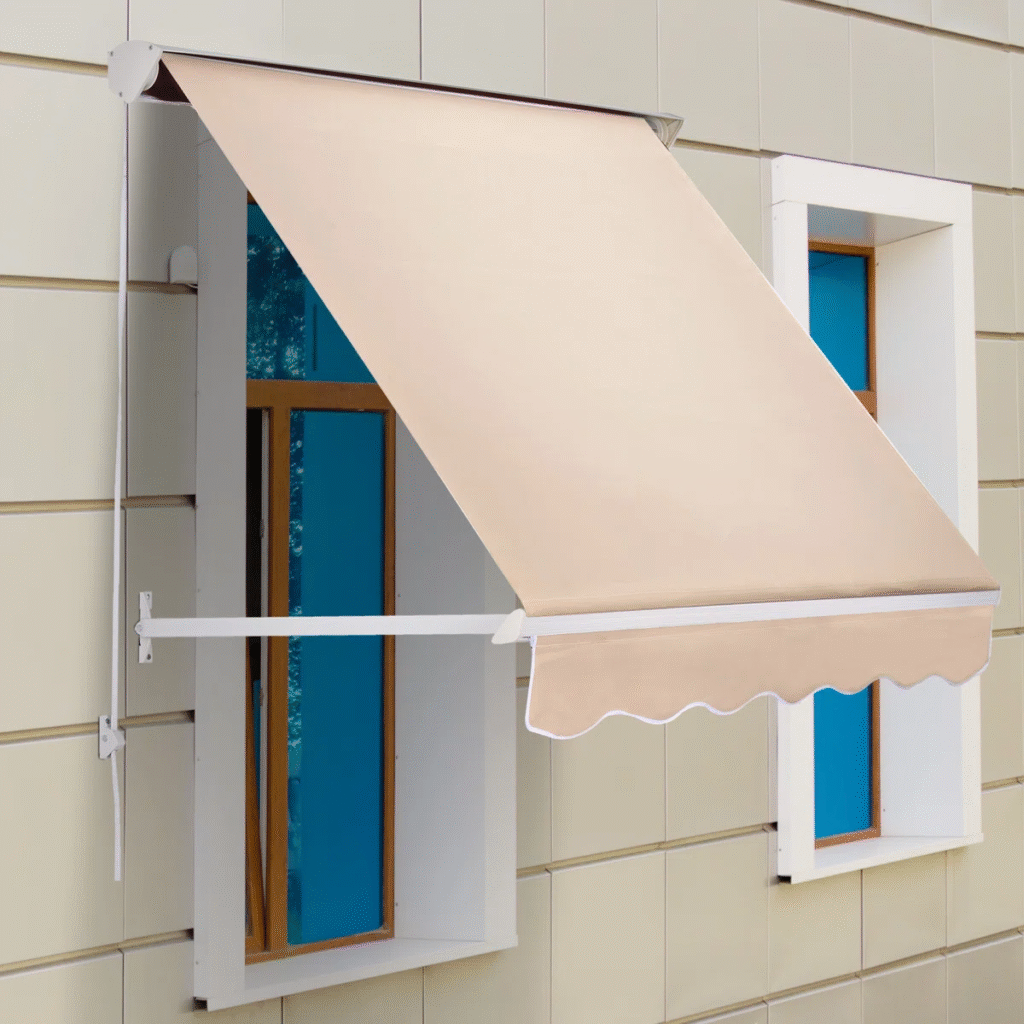
Common styles include “canopy style” (covering a large area) and “window sill style” (designed for windows or small balconies).
Benefits of awnings for outdoor spaces
The shade area is always stable: after unfolding, it can cover a fixed area of 5-20㎡ (such as the entire terrace or outdoor sofa area).
No matter how the sun moves, as long as it shines obliquely on the roof, the bottom can always remain cool and cool, without frequent adjustments.
Strong enough to resist wind and rain: high-quality retractable awnings can withstand winds of level 5-6 (about 39-49km/h), and can also block rain in moderate rainy weather, preventing rain from wetting outdoor furniture (such as sofas and dining tables).
Protect furniture for long-term durability: It can block more than 90% of ultraviolet rays and direct sunlight, prevent outdoor sofas and carpets from fading and aging due to exposure to the sun, and extend the service life.
Expanding the living area: It is equivalent to adding a semi-open room to the outdoors. You can drink tea under it on rainy days and have a dinner under it in summer, making the outdoor space available all year round instead of seasonal use.
Explore Sunshade Umbrellas
What are outdoor sunshade umbrellas?
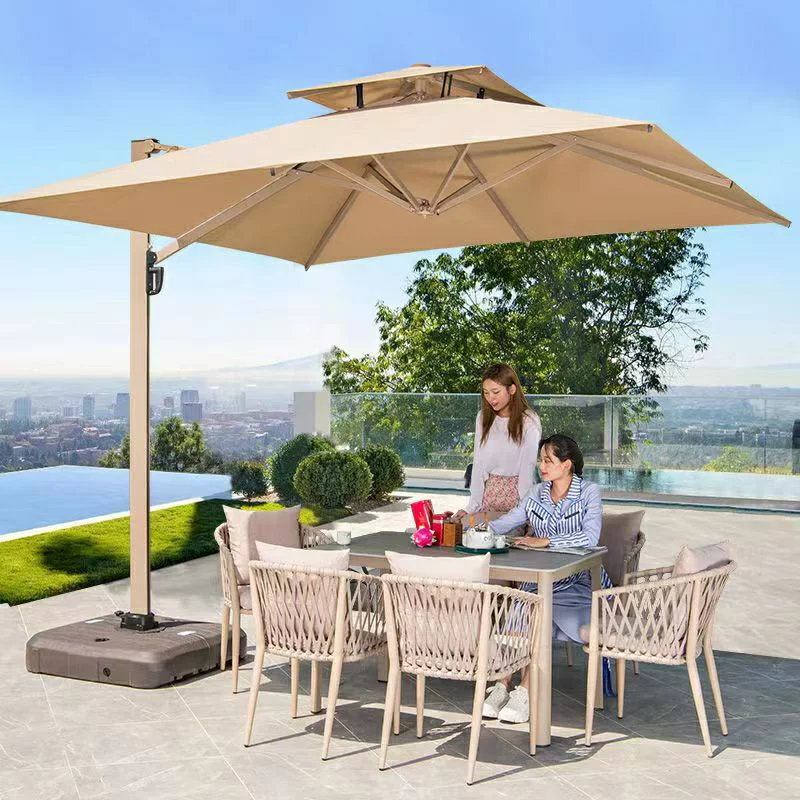
An outdoor sunshade is a movable column-type sunshade tool, with a central column supporting a round or square umbrella (diameter varies from 2 to 5 meters).
The umbrella is mostly made of polyester, canvas or waterproof Oxford cloth, and the height and angle are adjusted by manual opening and closing or cranking.
It does not need to be fixed and can be placed directly in the courtyard, by the pool, in the corner of the terrace, and even when camping. It is a “flexible” outdoor sunshade.
Advantages of using parasols
Flexible mobility: two people can easily move it. If you want to use it on the lawn today, you want to move it to the pool tomorrow, and you can move it to the campsite the day after tomorrow.
It can be used and placed wherever you want, and can also be used when renting a house or living for a short period of time.
Easy installation: unpack the package, put the base firmly (fill it with sand or water to increase the weight), open the umbrella and you can use it. You don’t need to drill holes in the wall or ask a master to install it. It can be done in 10 minutes.
Affordable price: The basic model can be purchased for a few hundred dollars, which is much lower than the initial investment of the awning. It is suitable for families with limited budgets or occasional outdoor space.
Diverse scenes: From a small two-person table on the balcony to a large 4-person dining table in the courtyard, you can find a parasol of the right size; some can also rotate and tilt the umbrella 360° to accurately block the sunlight at different angles.
Comparison between outdoor awnings and outdoor sun umbrellas
I.Comparison of sunshade and rain protection performance
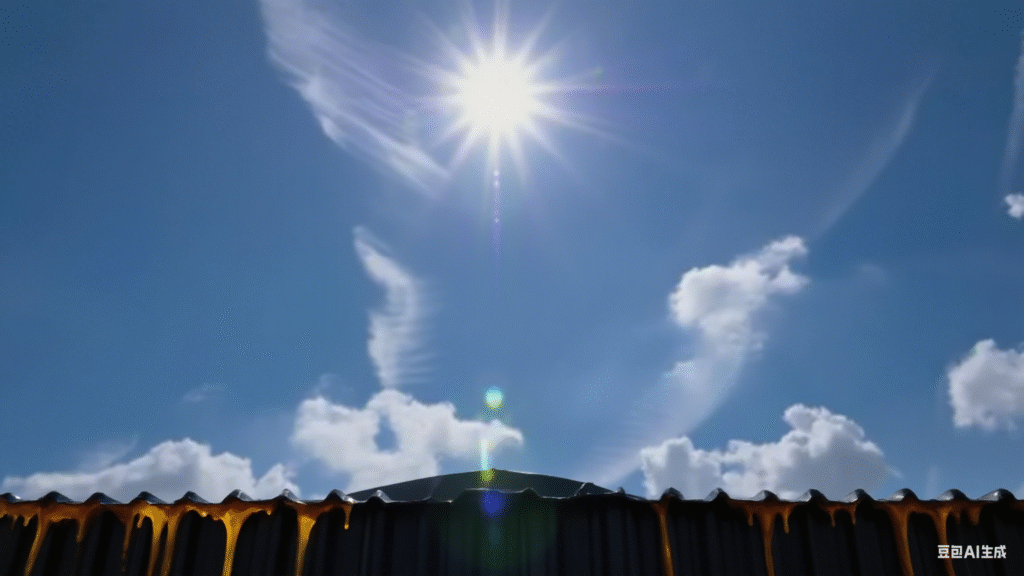
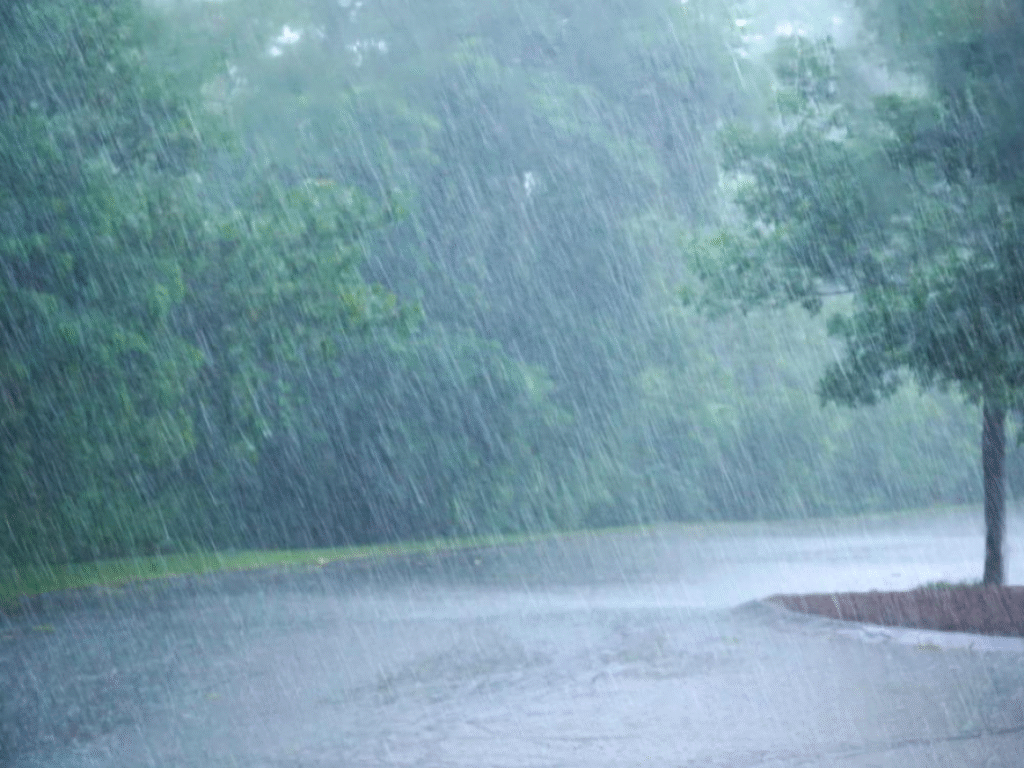
What people care most about when buying sunshade products is their sunshade and rainproof performance.
Retractable awnings: are usually made of high-density coated fabrics (such as acrylic cloth or polyvinyl chloride cloth), which have excellent UV blocking effects and can effectively block up to 98% of harmful UV radiation.
This can effectively shade the outdoor area under the awning, thereby improving overall energy efficiency.
In addition, the high-density coated fabric is also highly waterproof, and with the inclined structure, it can effectively guide rainwater to drain away.
For daily light rain or short-term moderate rain, the awning is fully competent to keep outdoor seats, balconies or courtyards dry.
However, it should be noted that awnings are not designed for extreme weather: in heavy rain or windy weather, the awning should be retracted in time to avoid structural damage.
If long-term sun protection and rain protection are the main needs, you can consider a fully cassette electric awning.
Most outdoor parasols: are made of polyester or polyester fabrics, with a thickness of about 160~280g/m². They are usually coated with UV protection to enhance the ability to shield against ultraviolet rays.
High-quality parasols can provide ultraviolet protection of UPF 30~50, which is enough to cope with daily strong sunlight.
Adjustable tilt angle designs (such as side-standing umbrellas or swing arm umbrellas) can also flexibly adjust the shaded area according to the direction of the sun.
In addition, parasols also have a certain waterproof effect, but their waterproof strength is weaker than that of awnings.
II.Wind resistance comparison
For outdoor building structures, whether they can block the sun is one thing, and whether they can “withstand” strong winds is another.
So can retractable awnings and outdoor parasols be competent for such high-intensity tests?

The wind resistance of the fully cassette retractable awning is to withstand wind speeds up to 19-24 miles/hour (about 29-38 kilometers/hour), which is equivalent to Beaufort wind scale level 5, that is, 17-21 knots. This level of wind: Increase in wave heights, foam splashes in the air, difficulty walking upwind.
The wind resistance of outdoor parasols can reach about Beaufort wind scale 4, which is about a wind speed of 20-28km per hour, but this is considered very strong among parasols.
III. Design and Aesthetics

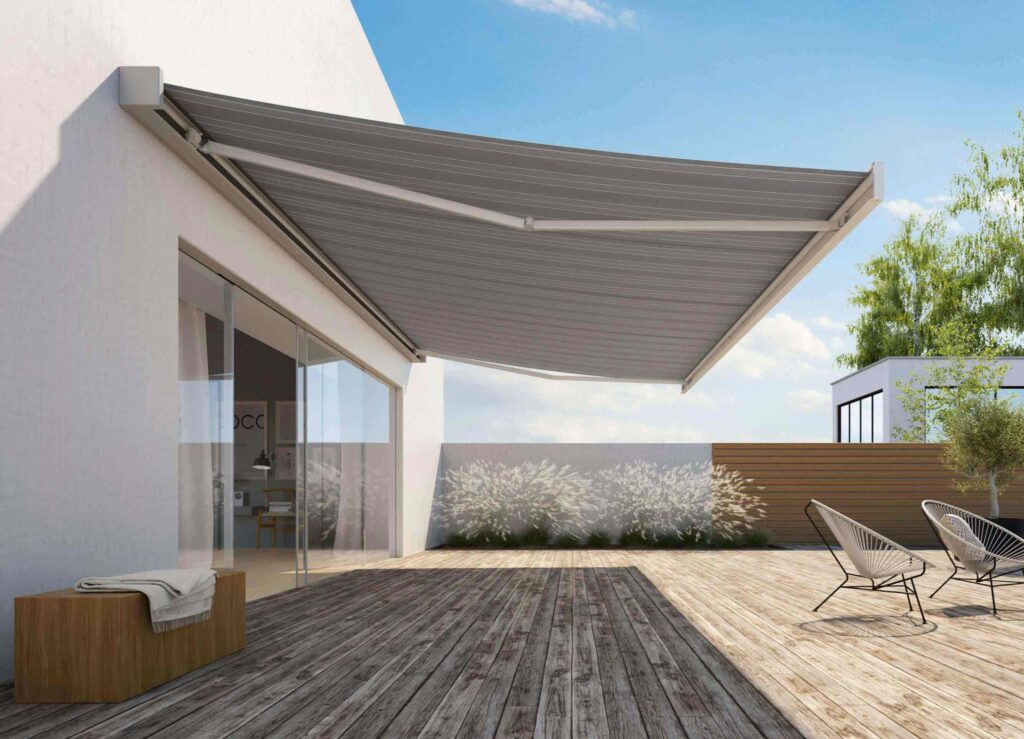
As the visual protagonist of outdoor space, awnings can often enhance the temperament and style of the entire courtyard, balcony or commercial place.
The appearance design of modern awnings has long been free from the traditional “cloth + pole” combination, and gradually moved towards minimalism, streamline and modularity:
- Full box shell design: When folded, it looks like a clean wall decoration, hiding the awning, arm and motor, with a strong sense of lines and a more modern feel.
- Invisible arm structure: The high-end model uses a hidden folding arm or track storage system, which makes the awning more concise when unfolded, without destroying the beauty of the facade.
- Freely customized proportions: The length and extension size can be tailored according to the building structure to avoid the embarrassing scene of “half covered and half exposed”.
- Color and material: The fabric of the awning is no longer limited to a single beige or gray, and can be customized in size, color, and pictures according to your architectural style.


The existence of outdoor parasols is far more than just blocking the sun. In outdoor spaces, a well-shaped and color-coordinated parasol can often be the finishing touch – whether it is a private courtyard, a corner of a balcony, or a restaurant outdoor or by the pool, it is a practical and romantic existence.
The shape design of modern parasols has far exceeded “neutral umbrella + simple fabric”:
- Side umbrella/cantilever umbrella: Move the bracket to one side to release all the space under the umbrella, which is more transparent and stretchy visually, and is very suitable for outdoor dining areas or sofas and lounge chairs.
- Multi-angle rotation design: Some high-end umbrellas can be rotated 360° and tilted, which is not only practical, but also more technological and modern.
- Foldable storage and low-key base: combined with cast iron or marble base, the parasol is like a quiet outdoor sculpture when not in use, which can be folded and unfolded freely.
- Brand-specific custom colors: Enhance recognition and create memorable moments in commercial spaces.
High-quality parasol fabrics often feature high color fastness, fade resistance, UV resistance, mildew resistance, and stain resistance, ensuring both aesthetic appeal and weatherproofing.
IV.Convenience
If I had to pinpoint the biggest difference between an awning and a parasol, it would have to be portability.
There are two types of portability: one is whether it is easy to carry around, and the other is whether it is easy to open and close.
From the perspective of whether it is easy to carry:
Awnings are definitely outperformed because, as we all know, they’re fixed to porches or windowsills, making them unportable.
The biggest advantage of outdoor umbrellas is their portability. You can take them camping, picnics, or use them by the pool as a sun umbrella. You can even use them for commercial purposes.
Regarding opening and closing
Modern awnings are equipped with motorized systems, allowing them to be opened and closed via remote controls or smart home systems. They are particularly suitable for large, frequently used spaces.
Optional wind and rain sensors can automatically retract in inclement weather, protecting the structure and fabric.
This significantly improves convenience and safety for commercial spaces (such as restaurant seating areas) and for elderly users.
outdoor parasols as technology advances, more and more large-sized, side-standing, or double-panel umbrellas now feature motorized opening and closing.
A single-touch opening and closing eliminates the manual effort and difficulty of adjusting traditional large umbrellas.
Some models also feature lighting strips, USB ports, or wind control systems, creating functions similar to “mobile smart awnings.”
They are particularly suitable for use in areas such as hotel pools, outdoor exhibition areas, and garden reception areas, where quick deployment and adjustment of the shade angle are essential.
V.Cost Comparison: Different prices reflect different product priorities.
Awnings and parasols differ in initial investment and long-term maintenance costs, depending on frequency of use, location, and level of intelligence.
| Aspect | Retractable Awning | Patio Umbrella |
|---|---|---|
| Initial Cost | Medium-High to High | Low to Medium to High |
| Installation Cost | High (requires professional installation) | Minimal to none |
| Maintenance Cost | Medium (motorized parts require upkeep) | Low (simple mechanical structure) |
| Flexibility | Fixed position | Freely movable |
Retractable Awnings:
Initial cost is higher: Regular manual models typically cost between $3,000 and $6,000, while high-end motorized models (with smart sensors, fully cassette systems, etc.) can cost $10,000 to $30,000+.
Installation costs are significant: This involves drilling holes for mounting, wiring, and wall structural assessment, requiring professional installation.
Maintenance costs are moderate: The motor and sensors require regular inspection, but the structure is robust, and the fabric replacement cycle is generally 5-10 years
Patio Umbrellas:
Flexible initial cost: Small manual umbrellas cost only a few hundred dollars, while mid-to-large brand umbrellas range from $1,000 to $5,000; high-end motorized umbrellas can cost $8,000 to $20,000.
Low or almost zero installation cost: No need to attach to a wall, they can be moved around.
Low maintenance cost: Umbrellas without motors require virtually no maintenance, and the cost of replacing fabric or parts is relatively low.
VI.Durability and Lifespan
The durability of awnings and parasols depends on the quality of their materials, the environment in which they are used, and how well they are maintained. Generally speaking:
Retractable awnings:
The frame is typically made of high-strength aluminum alloy, which is highly corrosion-resistant.
The tarpaulin’s service life is generally 5-10 years, but if high-strength tarpaulin is used, the service life can reach 10-15 years.
The motor system’s lifespan depends on frequency of use and climate, with a typical maintenance interval of 5-8 years.
For long-term, stationary use, awnings offer a stable overall structure, strong wind resistance, and a more manageable lifespan.
Outdoor parasols:
Umbrella frames are made from a variety of materials (aluminum alloy, steel, mid-range and high-end solid wood), and their rust-resistant treatment ensures durability.
The fabric is typically made of polyester or acrylic, and its UV resistance and color fastness determine its lifespan, typically 6-10 years.
Electric parasols also require regular maintenance on their motor system, but their overall structure is simpler.
Frequent movement or opening an umbrella in windy weather may shorten its lifespan.

